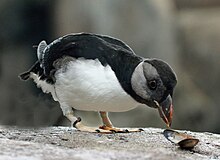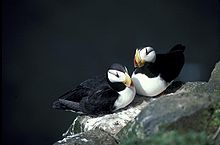Horned puffin
| Horned puffin | |
|---|---|

| |
| Scientific classification | |
| Kingdom: | |
| Phylum: | |
| Class: | |
| Order: | |
| Family: | |
| Genus: | |
| Species: | F. corniculata
|
| Binomial name | |
| Fratercula corniculata (Naumann, JF, 1821)
| |
The horned puffin (Fratercula corniculata) is an auk, similar in appearance to the Atlantic puffin. It is a pelagic seabird that feeds primarily by diving for fish. It nests in colonies, often with other auks.
Description

The height of the adult bird is approximately 8 in (20 cm), the weight is approximately 500 g (18 oz), and the wingspan is approximately 23 in (58 cm).[2] Horned puffins are monomorphic (the male and female exhibit the same plumage coloration). Sexually mature birds have a small fleshy black "horn" extending upwards from the eye, from which the animal derives its common name — the horned puffin. A dark eyestripe extends backwards from the eye towards the occiput. The cheeks are white, with a yellow fleshy spot at the base of the bill.
In summer (breeding) plumage, the outer keratinous layers of the bill — the rhamphotheca[3][4] — grow in size and change to a bright yellow color at the base and dark orange at the tip. The size and color of the rhamphotheca helps to attract a mate. The brilliant outer layers of the rhamphotheca are shed in late summer. The face reverts to a gray and black color, with a smaller, less brilliantly colored bill, and the legs and feet fade to a pale fleshy color. This phase is referred to as eclipse plumage.
Like many other seabirds, the horned puffin is countershaded for camouflage against both aerial and undersea predators. The underparts (breast, throat, belly, flanks and vent) are white, while the upper parts (mantle, scapulars, coverts, primaries, tertials and rump) are black. The legs and feet are orange.
Behavior

This species winters far out to sea, and breeds on rocky islands off the coasts of Siberia, Alaska and British Columbia. One white egg is usually laid in a crevice or cavity among the rocks.
Hunting areas are usually located fairly far offshore from the nest. Horned puffins will return from hunting with several small fish, squid or crustaceans in their specialized bills. Unlike many other seabirds, which employ regurgitation to feed their young, the horned puffin feeds intact fish from its bill to the chick. Both parents participate in the feeding and rearing of the chick.
The population of these birds has declined due to the introduction of rats onto some islands used for nesting.
References
- ^ Template:IUCN
- ^ Alaska SeaLife Center (2016). "Horned Puffin". ASLC resident species. Seward, Alaska: Alaska SeaLife Center. Retrieved 2016-10-15.
- ^ Proctor, NS; Lynch, PJ (1998). Manual of Ornithology: Avian Structure and Function. New Haven: Yale University Press. p. 66. ISBN 0-300-07619-3.
- ^ Gill, FB (1995). Ornithology (2nd ed.). New York: W. H. Freeman and Company. p. 66. ISBN 0-7167-2415-4.
- "National Geographic" Field Guide to the Birds of North America ISBN 0-7922-6877-6
- Seabirds, an Identification Guide by Peter Harrison, (1983) ISBN 0-7470-1410-8
- Handbook of the Birds of the World Vol 3, Josep del Hoyo editor, ISBN 84-87334-20-2
- "National Audubon Society" The Sibley Guide to Birds, by David Allen Sibley, ISBN 0-679-45122-6

